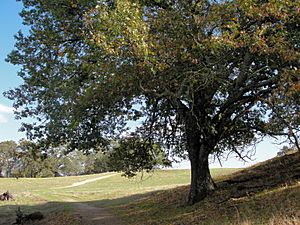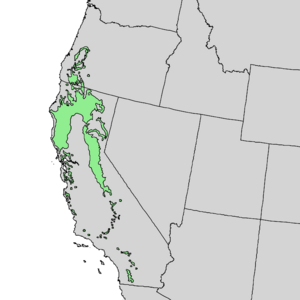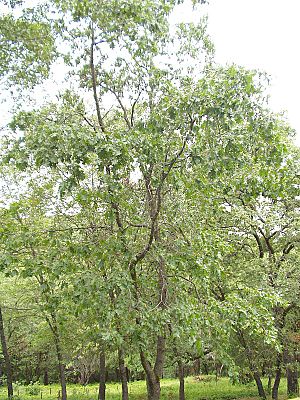California black oak facts for kids
Quick facts for kids California black oak |
|
|---|---|
 |
|
| Conservation status | |
| Scientific classification | |
| Genus: |
Quercus
|
| Species: |
kelloggii
|
 |
|
| Natural range | |
| Synonyms | |
|
|
The California black oak, also called Kellogg oak, is a special type of oak tree. Its scientific name is Quercus kelloggii. This tree grows naturally in western North America, especially in California and Oregon. It belongs to the "red oak" group of trees. Even though it's been separate for millions of years, its leaves look a lot like other red oaks found in eastern North America.
Contents
Where Does the California Black Oak Grow?
The California black oak is a deciduous tree, meaning it loses its leaves each year. You can find it in different kinds of forests, like mixed evergreen forests and coniferous forests. It grows in the foothills and lower mountains of California and western Oregon.
This tree is found from Lane County, Oregon, all the way south through the Cascade Range, the Sierra Nevada, and the Pacific Coast Ranges. It can grow alone or mixed with other trees. If you see a forest with only California black oaks, it often means the spot isn't great for other trees, or there have been fires or logging. This oak can grow in many soil types, but it needs soil that drains water well.
What Does a California Black Oak Look Like?
California black oaks usually grow between 9 and 25 meters (about 30 to 80 feet) tall. Their trunks can be 0.3 to 1.4 meters (about 1 to 4.5 feet) wide. Some very old trees can be over 36 meters (118 feet) tall and 1.6 meters (5 feet) wide! Sometimes, on poor land, this tree might grow more like a shrub.
In open areas, the tree's top part (called the crown) is wide and round. Its lower branches might almost touch the ground. In thick forests, young trees have narrow crowns, while older ones have crowns that are wide but uneven. The lower part of the trunk is often clear of branches. Older trees often have trunks that split or are hollow inside.
The bark is thin and smooth when the tree is young. As it gets older, the bark becomes thick, rough, and looks like plates. This oak has deep roots that go down to bedrock. It also has roots that spread out near the surface.
The Acorns of this tree are quite large. They are about 2.5 to 3 centimeters (1 to 1.2 inches) long. The leaves have deep lobes (rounded sections) and are usually 10 to 20 centimeters (4 to 8 inches) long. Most California black oaks live for 100 to 200 years. However, some can live for up to 500 years!
The tree usually reproduces when its acorns sprout into new seedlings. It can also regrow from its roots if the top part of the tree is destroyed. This can happen after a wildfire, logging, or frost.
How Does This Oak Help Nature?
The California black oak is super important for wildlife. Oaks are perhaps the most important trees for food and shelter for animals in California. The California black oak covers more land than any other hardwood tree in the state. Farm animals also use these trees for food and shade.
Holes in the trees provide homes for owls, different kinds of woodpeckers, tree squirrels, and black bears. The trees offer valuable shade for animals during hot summers. Black bears often use California black oak forests for shelter in spring, summer, and fall.
Deer and farm animals eat the leaves and branches. Acorns are a favorite food for many animals, including deer, wild pigs, rodents, mountain quail, Steller's jay, and woodpeckers. Acorns can make up half of the diet for western gray squirrels and black-tailed deer in fall and winter when there are lots of acorns. When there are more acorns, more deer fawns (baby deer) survive.
Many birds like to find food on California black oaks. In one study, all 68 bird species seen in oak woodlands used this tree for foraging. Birds like the Acorn woodpecker and Bullock's oriole especially love this tree. The parasitic plant called Pacific mistletoe, which often grows on this oak, has berries that also attract birds.
Many animals like to hide acorns for later. Acorns that are buried in the ground are more likely to sprout than those left on the surface.
This tree is good at surviving wildfires. Its thick bark protects it from smaller fires. If a big fire burns the tree down, it can easily grow back from its roots. It has lots of nutrients and water stored there. Acorns also sprout well after a fire, especially in areas where the ground has been cleared.
However, this oak can get a disease called sudden oak death.
What Are California Black Oaks Used For?
Some Native American groups preferred California black oak acorns for making acorn meal. Historically, these acorns were a very important food source for many Native American communities. Native Americans understood how important fire was for this oak. They would purposely start fires in oak woodlands to help the trees stay healthy and ensure they had food.
The wood from this tree is used to make furniture, pallets, and building materials. It is also planted as an ornamental tree in gardens and parks because it looks nice.
Timber and Wood Use
California black oak makes up a big part of California's hardwood timber. It's the main hardwood tree that is cut into lumber there. In the past, foresters sometimes thought of this tree as a "weed tree." They even tried to remove it to make space for other trees like pines and firs.
However, some people, like Guy Hall in the 1960s, saw the value in the California black oak. He helped convince government groups to stop trying to get rid of these trees.
New forests of California black oak have been successfully grown from acorns. Taking out some trees in these new forests helps the remaining trees grow better and produce higher quality wood. This tree can also grow well in places where other trees might struggle.
Growing California Black Oaks
Quercus kelloggii is grown by special plant nurseries. People buy it as an ornamental tree for their yards. It's popular for gardens that use less water and for projects that restore natural habitats.
See also
 In Spanish: Quercus kelloggii para niños
In Spanish: Quercus kelloggii para niños




